A PHOTO PAGE
FOR
Charles Conrad Young
and family
|

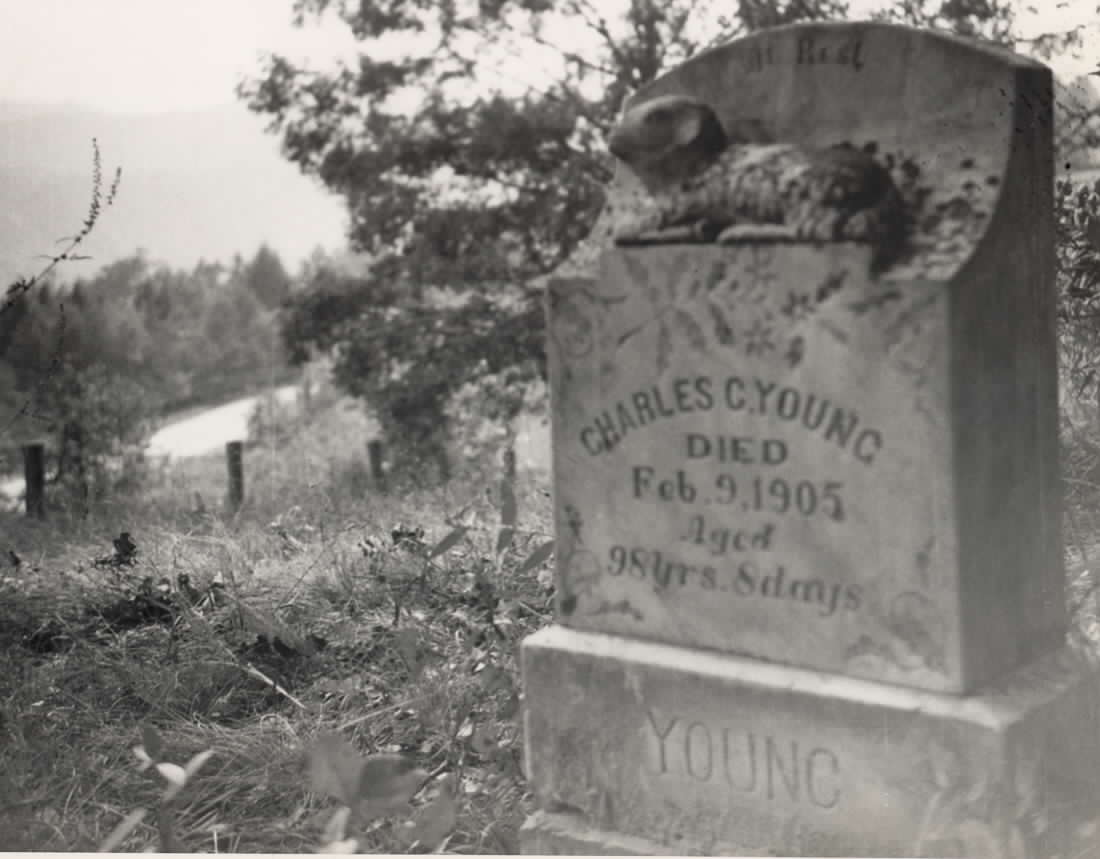
Charles Conrad Young, born the first day of February 1807, died
ninety-eight
years and eight days later. He is buried just above Hawks Nest, WV.
U.S. Route 60 is visible in the backgraound. My understanding is that
my
granduncle George Stanley is buried there also. I do not know
the name
of this cemetery, but I could find neither grave listed in the Fayette
Co.,
WV, cemetery listings.
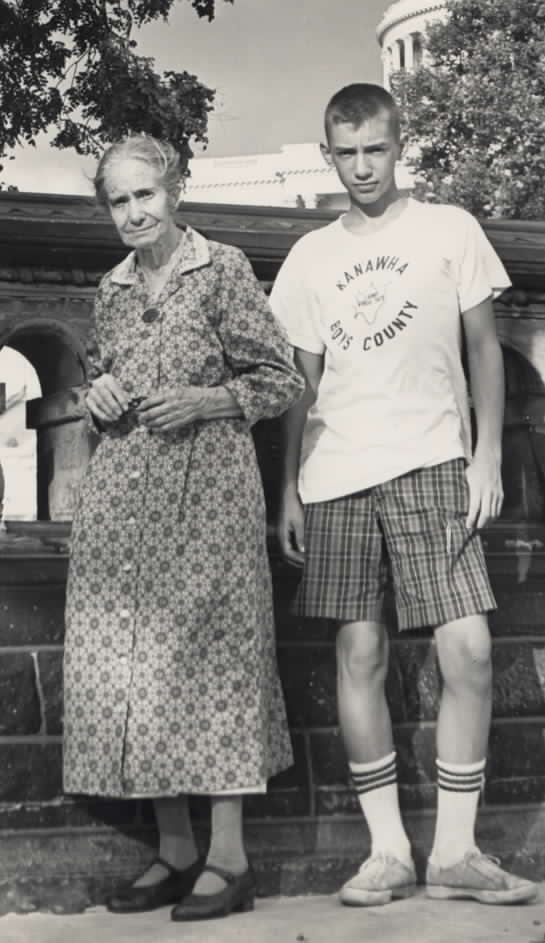 Miss
Maude Ella Stanley? Yes, but we only called her Aunt Maude.
(Like my brother Pat says, say "ant," not "ont.") I've heard many
stories about her. I can tell a few myself. I knew her well,
I think, though not as well as my mom and her sisters and brothers.
She was my grandaunt, the firstborn of George Washington Stanley and Fannie
Young Stanley. The entire time I knew her, it seems, she looked like
this. I guess I thought she always had, and that she'd live forever.
Miss
Maude Ella Stanley? Yes, but we only called her Aunt Maude.
(Like my brother Pat says, say "ant," not "ont.") I've heard many
stories about her. I can tell a few myself. I knew her well,
I think, though not as well as my mom and her sisters and brothers.
She was my grandaunt, the firstborn of George Washington Stanley and Fannie
Young Stanley. The entire time I knew her, it seems, she looked like
this. I guess I thought she always had, and that she'd live forever.
A native West Virginian, she'd lived at the old homeplace
at Tad, up Campbells' Creek, all her life. Her daddy, George Washington
Stanley, had married his sweetheart, Fannie Young, and built the place
for his bride sometime after the Civil War. Maude was their first
child. She grew up to become a school teacher, and many a Campbells'
Creeker remember her lessons. She never married, and I never heard why.
Going to Aunt Maude's was always an adventure for us kids
in the 1950's and 60's. The old wellhouse, the outhouse, the graveyard
up on the side of the hill behind her house, the yard, the little creek
off to the side--all of it was as exciting to my brother and me as Christmas
morning. Oh, and the house! It was close to a hundred years
old then, and with its tin roof, its weather-faded green siding, and slightly
sagging front porch, it looked (and was) even more ancient and age-wrinkled
than Aunt Maude herself.
My uncle Buster (Albert McDonald Keeney of Belle,
Mamie's and Mack's fifthborn), who's almost as old today as Aunt Maude
was then, was talking with me by phone the other day about her and that
old house. He told me the back of the house used to be the front
and vice-versa. Long ago, when they first built it, the homeplace
faced the old road up Campbells' Creek which was much closer to the north
side of the hollow, right up against the hillside, and the house was built
to face it. In those early days, the road went right through where
the back yard was when I knew it in the 1950's.
There's a story I heard growing up about two men on horseback,
around the turn of the century, who had met in the road and were exchanging
words right in front of the house. Both had pistols strapped to their
waists, and their topcoats were pulled back behind, hands prepared to draw.
With fire in her eyes, a tiny Aunt Maude walked off the porch and across
the yard, right up to where they had squared off in their saddles.
"Gentlemen," she ordered firmly, "there'll be no fighting here today!"
The two tipped their hats, said, "Yes, ma'am," and rode off in opposite
directions!
Uncle Bus told me that after the new road was built BEHIND
the house (between the house and Campbells' Creek), they redid the house,
removing the porch and adding it onto the old back to make it into the
new front. Several rooms were changed, and a new bedroom was added,
I believe he said. The outhouse was moved to the new back yard and
placed right in the middle of where the old road had been! I suppose this
change would explain why her bed was in the living room. When one walked
in the front door, that was the first noticeable thing. A double bed, it
was, there was a rocker--or maybe two--between it and the door. One
had to walk around the bed to get to the door that led into the dining
room, though which one walked to get to the kitchen.
Another door to the right and rear of the living room
drew one into another bedroom, but no bed was there; instead, an ancient
parlor organ stood against the far front wall. Playing that old pumper
was always a treat. My uncle and aunt, (George McClure and Frankie Lucas
Keeney of Cow Creek, Putnam Co., Mack and Mamie's seventhborn and wife)
have that organ now, and long may it stand in the home of family. Also
in that room were Easter eggs. Many of them, kept as souveniers of long-ago
egg hunts, lined a table or dresser top along the wall beside the organ.
There were always several dippers made from dried gourds
lying around, as I recall, and it was more than once that I got to help
turn the crank to draw a bucket of drinking water from the old covered
well. I don't remember ever drinking from a gourd dipper, as Aunt
Maude always had glasses for us. I suspect we poured that water into
a pitcher to use in the house. It was quite an exciting day in the
late 1950's when Aunt Maude finally got running water piped into
her kitchen! The well was boarded over and never used again.
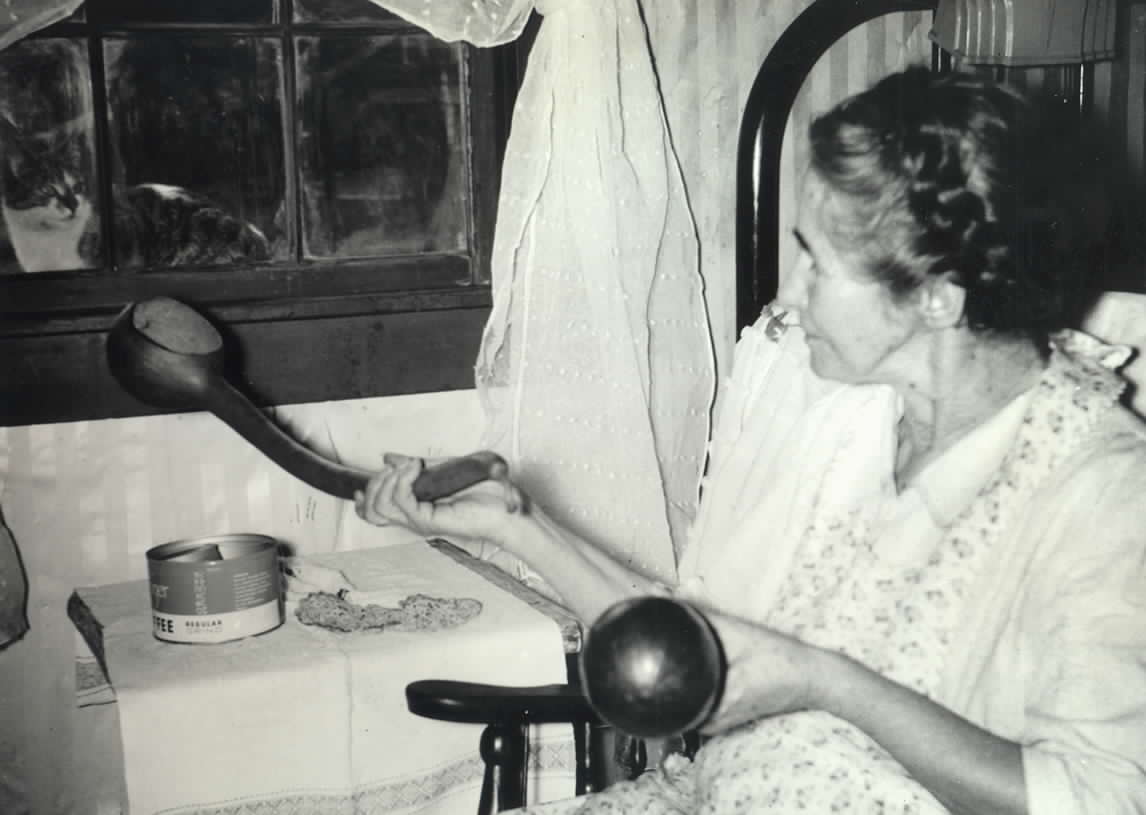
88th birthday cake
trip to the beach
easter egg hunts
sunday afternoons
gourd dippers!
hand-tatted lace doilies
iron beds
Ms. Ida in a bonnet!
spoons in a glass
the old pie safe
rockers everywhere
old rusted square steel tub in the front yard
many cats
falling off the commode at 7 Keiffer
meals and Mrs. (Thompson?), the "nurse" from up 2-and-3/4-mile
Creek
fingers were made before forks!
prayers at night at 7 K and in the motels
long hair always in a bun, always down at night
burying her
mom's memories in 2002 from her childhood w/At.Maude
5A Charleston Daily Mail May 25, 1996
LOOKING BACK
Patient Aunt Maude never went in hospital
By Adrian Gwin
Aunt Maude lived more than 90 years and never spent a minute in a hospital,
as a patient.
Poor Aunt Maude.
She never knew what she missed.
I've been in lots of hospitals lots of times and wouldn't take a pretty
for any of it.
Oh, she had her fun, and life didn't pass her by just because she never
got in a hospital.
I remember the day in 1961, the day after the "big flood" when the creeks
rose fast and furious and washed out everything and drowned several people
and flooded lots of homes.
I sat with her on the porch of the old Stanley home on Campbells Creek,
above the high water, while we watched the roiling flood come rolling down.
Another bunch of crossties and a section of rail went churning by, and
Aunt Maude sighed.
"I'm lucky, I guess," she said matter-of-factly, "I saw the railroad
go up the creek, and now I've lived to see it come down the creek."
She saw a lot more than that in her placid lifetime, without ever getting
into a hospital.
Once in her young adulthood she walked between two strange men with
drawn and cocked pistols, in the road before her front gate. Holding up
her hands she cried calmly: "Men, there'll be no shooting here today. Put
the guns away, and go back where you came from."
They put the pistols away, tipped their hats to the young lady, and
went about other business. That's the way they did things in the old days,
men as well as women. Today, getting between two men with pistols would
be a straight ticket to the hospital. But Aunt Maude never got in one as
a patient.
My first hospital term was before I went to school. I remember oh, so
well, that they took out my tonsils. I remember waking up in my room terribly
thirsty, and asking the nurse for a drink of water. My throat was a little
sore, but when I swallowed that gulp of water, it cut my throat.
It was the most terrible pain I ever had in my tonsils, and it was in
where my tonsils used to be. Lesson for a lifetime: Ask questions before
taking action in a hospital.
I was about 8 when I got in the outhouse of a hospital. Ma had put me,
deathly sick, on the train with instructions for the conductor to send
me to the hospital in town in a taxi. He did. I remember the taxi driver
helping me into the waiting room at the hospital, and I remember Dr. DuBose
coming in, taking one look, and saying: "Put that boy in the isolation
unit in the back yard. He's got the mumps."
But when I was 12, and got a dire illness of some sort, the hospital
stay was pleasant, for the most part. They got me to feeling almost normal,
then kept me for two weeks getting me well, and one of the "cures" was
injection of a huge amount of mercurochrome into my bloodsystem.
The doctor told me it would turn my urine blood-red--and it did. I was
fascinated with the red color and with watching it fade a little each day
until it was back to normal in about a week.
But the best part of that hospital trip was finding the "Jalna," which
began: "Wakefield Whiteoak ran on and on."
I went on to read that new 1929 novel twice, and afterward to read,
over the years, all the Whiteoak books by Mazo de la Roche as they came
out.
Army hospitals in World War II are best forgotten--but I still wouldn't
take a pretty for my time in them. Educational, to say the least.
Once in Thomas Hospital here in South Charleston, I saw a woman being
brought in who looked like she was going to have a baby--a baby elephant.
Later I overheard nurses say it was the biggest baby ever born there.
So I wandered down the hall and spent two of my newspaper nickels on a
phone call to Chuck McGhee, and he called the hospital and we got a story
in the Daily Mail about that biggest baby instead of waiting for
a routine news release.
That time I felt like being in the hospital got me a "scoop"--which
didn't happen very often.
Rest easy, Aunt Maude; you never needed a hospital in 90-plus years--and
that doesn't happen very often, either.
Copyright©2000 Charleston Newspapers Interactive
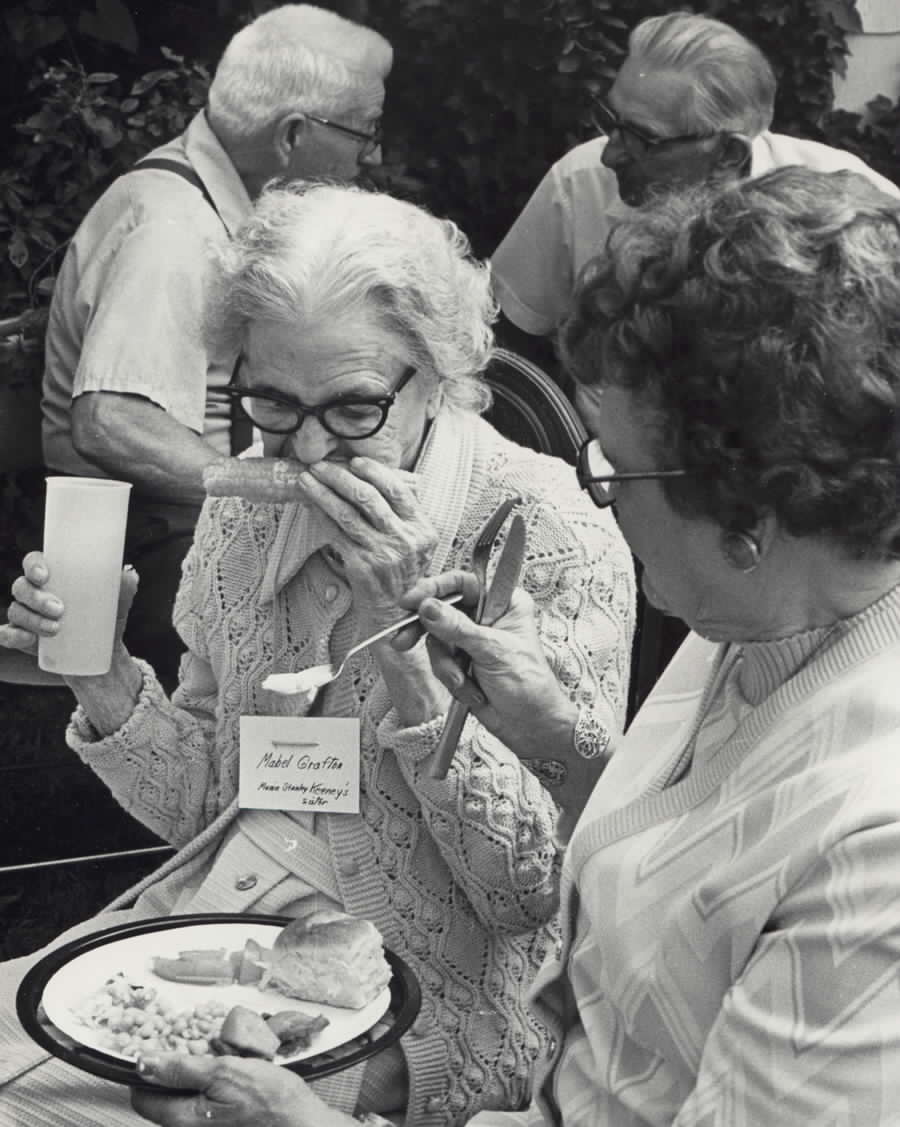 I'd
forgotten when Aunt Mabel was born, but I knew it was somewhere
mighty close to 1875. Can you expect to eat corn on the cob at a
family reunion when you're 100? Mabel Stanley Grafton did!
With daughter Dolly Grafton Corey holding Mabel's plate, she did
quite handily and thought nothing of it. This was the 1975 reunion
of the Keeney clan, and Mabel's baby sister Mamie Chloe Stanley
had married McDonald Keeney in 1911 to make the link.
I'd
forgotten when Aunt Mabel was born, but I knew it was somewhere
mighty close to 1875. Can you expect to eat corn on the cob at a
family reunion when you're 100? Mabel Stanley Grafton did!
With daughter Dolly Grafton Corey holding Mabel's plate, she did
quite handily and thought nothing of it. This was the 1975 reunion
of the Keeney clan, and Mabel's baby sister Mamie Chloe Stanley
had married McDonald Keeney in 1911 to make the link.
Aunt Mabel knew all the verses to "The West Virginia Hills"
by heart and would sing them on request at the drop of a hat. Widow
of Tom Grafton, she had five children, I believe, to help her see
her way to past the century mark.
Grandson John Corey sent me these grave photos
to cinch the dates down: Mabel Stanley Grafton, b. 18 Nov 1877;
d. 28 Sept 1981; Thomas Grafton; West Virginia, Pvt., Troop C, 8th
Regimental Cavalry; b. 8 Mar 1878; d. 24 Nov 1953.
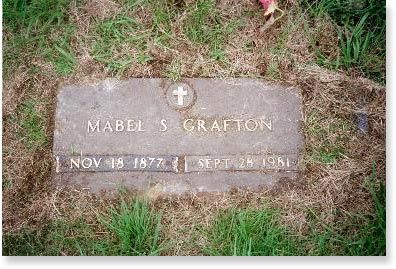
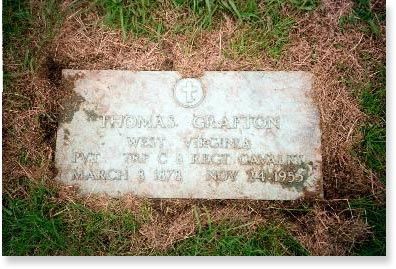
From: metromountain@juno.com
Date: Mon May 26, 2003 01:50:28 PM US/Mountain
To: jmcdgwin@zianet.com
Subject: Re: Adrian Gwin's thoughts on Memorial Day
Cousin John,
Started a message to you and my brother's computer erased it, so here
I go again!
Bonne Sue and her 55 year-old boyfriend
Don Zonstra from Michigan and I put fresh cut flowers from behind the house
on Zabel Drive on your great-aunt Mable's grave and her husband
Thomas
Grafton who served in the Spanish-American War in 1898; we also
honored our Corey grandparents who are buried beside them in Sunset Memorial
in Spring Hill.
George Stanley says your great-great-great-grandfather
Isaac
Stanley from George's Creek was married to a Wince; what do
you have on the Stanley/Wince lineage? I'm going to search eventually
to see what mom and her sister's Elizabeth and Eugenia used for their DAR
membership, unless you already have that information.
We had a memorial at the Baraca SundaySchool Class
at Calvary Baptist Church for dad and seven others; the daughters of Price
Ballard own Highlawn Funeral Home in Oak Hill and are supposed to help
me locate Margaret James (wife of Conrad Young buried next
to adopted George Stanley in the Hendrick Cemetery in the curve below Hawk's
Nest); she allegedly was buried under a big rock maybe in the IOOF Cemetery
in Oak Hill!
I'm off to Tall Cedar MD Convention in Wildwood,
NJ this coming weekend and then to Florida to visit cousins Mark &
Charles Thompson!
Keep in touch! John Corey


 Miss
Maude Ella Stanley? Yes, but we only called her Aunt Maude.
(Like my brother Pat says, say "ant," not "ont.") I've heard many
stories about her. I can tell a few myself. I knew her well,
I think, though not as well as my mom and her sisters and brothers.
She was my grandaunt, the firstborn of George Washington Stanley and Fannie
Young Stanley. The entire time I knew her, it seems, she looked like
this. I guess I thought she always had, and that she'd live forever.
Miss
Maude Ella Stanley? Yes, but we only called her Aunt Maude.
(Like my brother Pat says, say "ant," not "ont.") I've heard many
stories about her. I can tell a few myself. I knew her well,
I think, though not as well as my mom and her sisters and brothers.
She was my grandaunt, the firstborn of George Washington Stanley and Fannie
Young Stanley. The entire time I knew her, it seems, she looked like
this. I guess I thought she always had, and that she'd live forever.

 I'd
forgotten when Aunt Mabel was born, but I knew it was somewhere
mighty close to 1875. Can you expect to eat corn on the cob at a
family reunion when you're 100? Mabel Stanley Grafton did!
With daughter Dolly Grafton Corey holding Mabel's plate, she did
quite handily and thought nothing of it. This was the 1975 reunion
of the Keeney clan, and Mabel's baby sister Mamie Chloe Stanley
had married McDonald Keeney in 1911 to make the link.
I'd
forgotten when Aunt Mabel was born, but I knew it was somewhere
mighty close to 1875. Can you expect to eat corn on the cob at a
family reunion when you're 100? Mabel Stanley Grafton did!
With daughter Dolly Grafton Corey holding Mabel's plate, she did
quite handily and thought nothing of it. This was the 1975 reunion
of the Keeney clan, and Mabel's baby sister Mamie Chloe Stanley
had married McDonald Keeney in 1911 to make the link.

